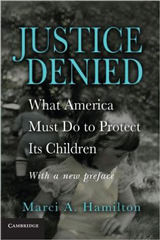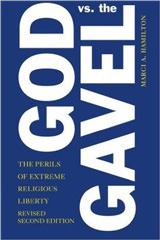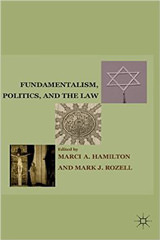Words matter. The phrase of the moment is “religious liberty.” The headlines are filled with the politicization of the term, which has stretched well beyond its constitutional meaning. Conservative Christians demand it (whatever it is) so that they do not have to mix with LGBT individuals or remotely endorse—or be perceived as endorsing—same-sex marriage. The ACLU is saying it is for making sure sex predators can go to church but not for companies to restrict contraception. The Church of Cannabis says it is for illegal drugs. The Little Sisters of the Poor say it is for not having to say what they believe in writing when the result is that the government accommodates their beliefs.
We did not talk about religious liberty like this until 1993, when the statutory religious liberty regime descended on America with the Religious Freedom Restoration Act. Before that, the First Amendment’s religious liberty meant that the government could not tell you what to believe; or tell a church how to organize itself; or try to run the Santerians out of town by passing a law that applied only to them. In addition, it was never a license to violate laws that undermine complex governing systems, like the tax system or for courts to act as experts on the military, or know-it-alls on prison regulations. It meant that Adell Sherbert could not be denied unemployment compensation for going to church when other employees could take time off without such a penalty, but that drug counselors could not use illegal drugs, even if in a religious ceremony, where that was a requirement for their jobs. Neither could a man take multiple wives even if for religious purposes, nor a religious organization order the government how to handle its own land.
Constitutional Religious Liberty
Each of these Supreme Court rulings was drawn from the sensible balance that the founding generation built into the first state constitutions, which created a right to religious liberty so long as it did not violate peace and safety, while at the same time forbidding licentiousness in the name of religion. They fundamentally understood the necessity of liberty and the need to place limits on it. What do we call a country with too much “religious liberty”? A tyranny of establishment, say like Iran or the traveling country that is ISIS. Or if you prefer a Western example, there was too much “religious liberty” at the Tower of London and in the Salem witch trials. The Supreme Court’s First Amendment jurisprudence reflected this crucial balance between liberty and license.
But the First Amendment rulings are also much more, because constitution-based religious liberty is situated in the larger Constitution. For example, when the federal courts interpret the First Amendment’s Free Exercise Clause, they must also take into account the separation of powers, which has meant that in the First Amendment religious liberty cases, judges exhibited a healthy humility for their role vis-à-vis legislatures and the executive. That explains some of the wisest decisions, like the Court’s rejection of a right of soldiers to determine their headgear by faith in Goldman v. Weinberger, but also Congress’s subsequent willingness to then expand opportunities for religious headgear. Under the Constitution, federal judges must, if they can, also avoid a constitutional ruling that would invalidate a law—out of respect for their fellow branches. Courts are part of a system of checks and balances, and mutual respect is demanded when constitutional rights are at stake.
Statutory Religious Liberty
That is not so when Congress makes up religious liberty as it did with the Religious Freedom Restoration Act in 1993 and then again in 2000. With statutory religious liberty, the built-in limitations on judicial activism in the Constitution melt away. RFRA instructs courts to throw caution to the wind and re-draft the legislation at issue to create a cozy cocoon around a single believer, with no reference to the institutional competence of a court to do so, and no concern for those who will be harmed when the believer breaks out of the cocoon to do whatever his or her beliefs demand.
Statutory religious liberty has led to the effective overruling of constitutional religious liberty decisions: believers have the right to carve out their own exemptions from complex national schemes, like national healthcare, and courts are now experts on military headgear, and know-it-alls on prison security.
In short, the term “religious liberty” has been bastardized. It simply does not mean the same thing in the constitutional and statutory contexts. It should come as no surprise that when Congress spawned religious liberty, it was a political tool, politically motivated, and sure to invite political discord without reference to constitutional principles that would otherwise wrap religious liberty into our republican form of government. When religious liberty became political tinder, it was debased and divorced from a balance between liberty and licentiousness and transformed into a ticket for courts to be super legislators and the believer to do whatever the believer wants. In other words, constitutional religious liberty requires consideration of all elements of the polity; statutory religious liberty is a prescription for self-aggrandizement whether judge or believer.
Thus, there is constitutional religious liberty that was in place until 1990 and which yielded remarkable peace and responsibility between believers and their society. And there is the statutory religious liberty post-1990 that tells believers to run over any law contrary to their belief.
Journalists Need to Be More Precise Even If Politicians Will Not Be
One cannot expect politicians to play fair with such intoxicating verbiage. “Ahh—my fellow Americans, I will give you religious liberty!!!”
Yet, journalists (including bloggers) have an obligation to the public to be accurate. “Religious liberty” is now an opaque term—often used to mislead as much as to illuminate. Compound terms are now needed for accuracy. There is “constitutional religious liberty” and there is “statutory religious liberty.” And, editors, please do not falsify the terms by insisting on what the lowest common denominator will understand. It is your job to educate as well as to report. So enough of letting candidates and public relations spinmeisters for the religious organizations spout “religious liberty” as the all-good that is a central part of our constitutional heritage. More often than not today, politicians are extolling statutory religious liberty but acting like it is constitutionally required and worthy of the reverence we should have for the First Amendment. For example, Scott Walker states: “Americans deserve a President who will fight and win for them. Someone who will stand up for the right to life, liberty and the pursuit of happiness. Someone who will stand up for our religious rights and all of our other Constitutional rights.” This is political bait and switch with the term “religious liberty.”
Tell it like it is: statutory religious liberty is all about political one-upmanship and gaining an advantage over policy via one’s beliefs. Constitutional religious liberty is about the sane and peaceful operation of a gloriously diverse representative democracy where believers, yes, even believers, have obligations to not harm others. To summarize, statutory religious liberty is not and never has been constitutional religious liberty.










Goldman v. Weinberger was a closely divided decision and there were various pre-1993 judicial rulings that protected religious exercise that would otherwise violate generally applicable laws. This included state rulings protecting the use of peyote. It is true that the USSC never really did something like that other than in the Amish school case (which Prof. Hamilton thinks is wrongly decided) but the opinions left open the rule she opposes. This is why the justice she clerked for, Justice O’Connor, strongly disagreed with the breadth of Oregon v. Smith.
the term is manipulated by both sides of the Church/State divide. The Catholic Church in particular moves in and out of secular issues regularly, but claims religious privilege whenever it suits their agenda. RCC is not shy about taking stances in the political marketplace, but their civil counterparts do seem to be reluctant to invade religious territory to investigate charges of criminality inside a religious institution. I know of at least one religious order that seems to be a breeding ground for pedophiles, but nobody has shut it down yet as a danger to the public. I think the next term to be deconstructed after “Religious Liberty” is “Deference”, and the role it plays in how secular authorities cut some slack for religious institutions who have erred—-slack, BTW, that would never be cut for an individual offender, particularly if they lack status and prestige.